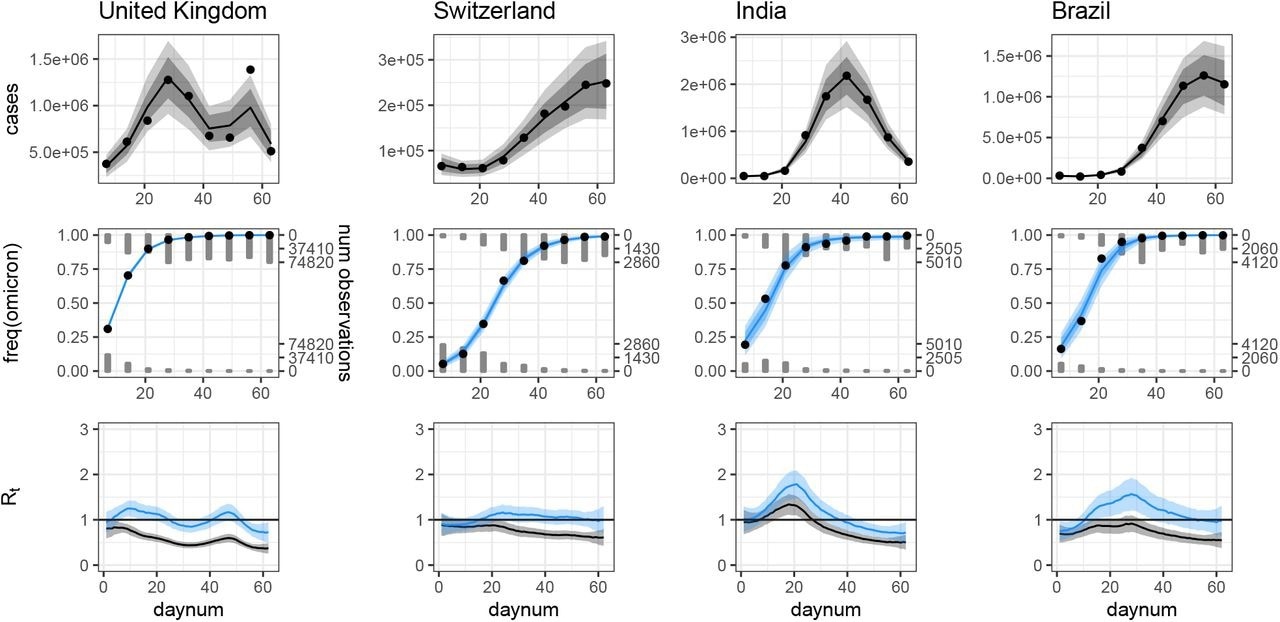The persistent evolution of the severe acute respiratory syndrome coronavirus 2 (SARS-CoV-2), the causal agent of the coronavirus disease 2019 (COVID-19), has prolonged the current pandemic.
This has led to the emergence of several SARS-CoV-2 variants, some of which have been classified as variants of concern (VOC) or variants of interest (VOI). These classifications are provided in accordance with their transmissibility, virulence, and capacity to evade the immune response generated through COVID-19 vaccination or natural infection.
Globally, a surge in COVID-19 cases occurred due to the circulation of the SARS-CoV-2 Alpha, Delta, and, more recently, Omicron variants.

Study: Global estimates of the fitness advantage of SARS-CoV-2 variant Omicron. Image Credit: RCW.studio / Shutterstock.com
Background
Previous studies on the SARS-CoV-2 Omicron variant revealed that this viral strain possesses higher transmission fitness as compared to the Delta variant. Moreover, these studies observed that the plasma neutralization activity of fully vaccinated individuals exhibited lower neutralizing activity against the Omicron variant.
These findings imply that the Omicron variant can effectively escape immune responses elicited after vaccination. However, a third booster dose of current COVID-19 messenger ribonucleic acid (mRNA) vaccines has improved the efficacy of vaccination against the Omicron variant.
Previous studies have highlighted the relative growth advantage of the Omicron variant in certain countries or settings as compared to other SARS-CoV-2 variants. However, the reason behind the heterogeneity in transmission fitness of these variants across countries remains unclear.
Scientists have hypothesized that this heterogeneity could be due to several reasons including the difference in circulating variants in each country, varied non-pharmaceutical preventive strategies, different immunological responses induced through vaccination and natural infection, as well as many other factors.
About the study
In a recent study published on the preprint server medRxiv*, researchers at Columbia University Irving Medical Center and Los Alamos National Laboratory quantify the transmission advantage of the SARS-CoV-2 Omicron variant across many countries and determine the factors associated with this heterogeneity using a hierarchical renewal model. Herein, the researchers also demonstrate the effectiveness of the model structure in quantifying the fitness of a viral variant.
The current study revealed that in a sample of forty countries, the heterogeneity associated with Omicron fitness could not be demonstrated through immunology-related covariates. However, a certain level of correlation with the fitness of the Delta variant was observed, thus suggesting the existence of fixed country-level effects.
Some of the parameters that the fitness of the renewal model depends upon include epidemic growth rates over time, case counts, and variant frequencies. Importantly, the authors suggest that the overall fitness of the model is significantly well, with a mean absolute error in the variant frequency of only 2.5 percentage points for data aggregated weekly. Additionally, for daily data, a mean absolute error in the variant frequency was estimated to be five percentage points.
Study findings
In the current study, the researchers addressed all structural anomalies in the epidemiological data by aggregating data weekly. Importantly, the renewal model was used to provide a reasonable estimate of the true trend, even during a sudden spike in reinfection cases.
For most of the countries across the world, the Omicron variant became the dominantly circulating strain within about thirty days. However, this variant was not associated with a sustained increase in the number of infections, as most of the countries exhibited a decrease in COVID-19 cases after Omicron’s confirmed arrival in each respective nation.
The model predicted that in countries like the United Kingdom, all COVID-19 cases within the study period could be attributed to the emergence and rise of the Omicron variant. This observation was based on the fact that for the entire study period, the effective reproduction number associated with the wild-type circulating strain remained less than one.
In most countries, the growth rate of the wild-type SARS-COV-2 variant decreased with the increase of the Omicron variant. This might be due to both competition with the Omicron variant for susceptible individuals, as well as the efficacy of both pharmaceutical and non-pharmaceutical interventions that had been implemented in response to the high transmission of the Omicron variant. Notably, this trend was not observed in India and Brazil.

Example model fits; all countries are shown in Fig. S1. Case counts (top row) and variant counts (middle row) are binned by week, while growth rates (bottom row) are predicted by day. Model-predicted growth rates are shown for the epidemic as a whole (both variants with their true frequencies; blue) and for only the non-Omicron variant(s) (as if the Omicron frequency were zero; gray). Model predictions are shown with solid lines (median), dark shading (95% credibility interval, which includes uncertainty in the model parameters), and light shading (95% posterior predictive interval, which additionally includes sampling noise).
The current model indicated that the selective advantage of the Omicron variant among countries across the world differed considerably. Moreover, the model assumed that the ratio of reproduction numbers for each country was obtained from a log-normal distribution, which was simultaneously calculated from the data.
The main advantage of the hierarchical structure was a reduction in structural biases presented by a country's data. Thus, a more robust prediction could be made based on the overall selection effect and heterogeneity at the country level.

(A) Estimates of the selection coefficient, s, for each country, under the hierarchical or non-hierarchical models. Points and lines show the median and 95% CrI. The slope of the data is steeper than the 1:1 line, meaning that the estimates are less extreme for the hierarchical model. (B) Summaries of estimates for the mean value of s for Omicron, and for the distribution of values of s across countries, computed from the hierarchical or non-hierarchical models. Points show the median or mean, and thick and thin lines show the 50% and 95% CrI or CI.
Conclusions
The hierarchical model used in the current study was confirmed to be effective on a global scale.
The researchers indicated that a higher selection coefficient for the Omicron variant could be associated with countries with greater immunity. However, the effect of several country-level immunity-related covariates was not statistically significant, which might be the result of inadequate variation among countries.
In the future, scientists will focus on understanding the factors that drive heterogeneity in the transmission of various viral variants across a particular country.
*Important notice
medRxiv publishes preliminary scientific reports that are not peer-reviewed and, therefore, should not be regarded as conclusive, guide clinical practice/health-related behavior, or treated as established information.
- van Dorp, C., Goldberg, E., Ke, R., et al. (2022) Global estimates of the fitness advantage of SARS-CoV-2 variant Omicron. medRxiv. doi:10.1101/2022.06.15.22276436. https://www.medrxiv.org/content/10.1101/2022.06.15.22276436v1.
Posted in: Medical Science News | Medical Research News | Disease/Infection News
Tags: Coronavirus, Coronavirus Disease COVID-19, covid-19, Efficacy, Evolution, Frequency, Immune Response, immunity, Immunology, Pandemic, Reproduction, Respiratory, Ribonucleic Acid, SARS, SARS-CoV-2, Severe Acute Respiratory, Severe Acute Respiratory Syndrome, Syndrome

Written by
Dr. Priyom Bose
Priyom holds a Ph.D. in Plant Biology and Biotechnology from the University of Madras, India. She is an active researcher and an experienced science writer. Priyom has also co-authored several original research articles that have been published in reputed peer-reviewed journals. She is also an avid reader and an amateur photographer.
Source: Read Full Article
